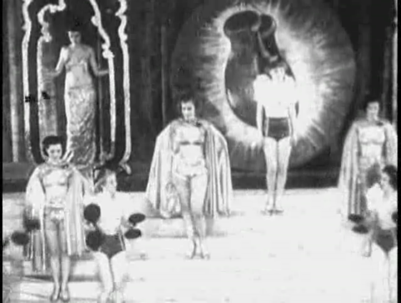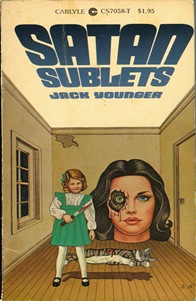
THE TAGLINE
"She sought big thrills... and caught big trouble! A country girl finds the crimson road."
THE PLOT
Paul Lorenz, son of the local anti-syphilis crusader, and a group of his pals head out to the Glorified Burlesque to catch a girlie show. Also attending are Peggy, Betty, and an unnamed child molester. Excited by what they've seen at the show, the lesbian Peggy bullies the bi-curious Betty into coming home with her while the molester stalks and kills a young girl. Meanwhile, Paul and the boys meet up with some of the show's dancers for a sex party and all end up with syphilis. One dancer, Millicent, skips the party however. She has an appointment with a doctor who is treating her for the syphilis she acquired after allowing herself to be pimped out by a theater manager in order to get a job. Unfortunately for Millicent the doctor she's seeing is a quack and lies to her about her condition. Believing herself cured, Millicent flees the big city and returns home to marry her childhood sweetheart. Inevitably, their child is born syphilitic and the husband goes blind. Overwhelmed by the consequences of her mistake, Mary prepares to poison herself and her family. Just in time, Mllicent's new doctor has found a possible treatment, but can he reach her in time to let her know?
THE POINT
So what would you do if you had an idea for a movie about wild sex parties, aggressive lipstick lesbians, and dancers who'll do anything (Anything? Anything!) for a job? Well, these days, you'd head over to HBO or Showtime, get a writing contract, and probably win an Emmy Award. But things weren't quite that easy back in 1938 when Sex Madness was filmed. Writing in the book Policing Cinema: Movies and Censorship in Early-Twentieth-Century America, Lee Grieveson notes that "legislative and reform activism in relation to cinema gathered pace after the proliferation of nickelodeons from 1906 on had opened moving pictures to lower-class and immigrant populations that had not previously frequented theatrical-style entertainments in any great numbers. Once at the cinema, these groups were subjected, many suggested, to a “carnival of vulgarity, suggestiveness, and violence” and to a “moral leprosy” that posed a serious “menace to the morals of the community and the healthy development of the social organism." In response to this perceived threat, a number of Protestant groups called for federal regulation of movie content.
Wary of government censorship, however, a number of prominent lay Catholics called for self-regulation within the movie industry and presented to Hollywood a code drawn up in 1930 by Father Daniel A. Lord, S.J. As described in Hollywood Censored: Morality Codes, Catholics, and the Movies by Gregory D. Black, this production code "prohibited films from glorifying criminals, gangsters, adulterers, and prostitutes. Lord's code, which soon became the Bible of film production, banned nudity, excessive violence, white slavery, illegal drugs, miscegenation, lustful kissing, suggestive postures, and profanity from the screen." (Which sounds pretty much like the content of tonight's schedule on Cinemax.) Hollywood didn't take to the code immediately though. The film industry basically ignored the document until 1934 when the Catholic Leagion of Decency finally threatened to boycott all movies at which point the code was quickly adopted. Arguing for freedom of expression is nice and all that, but when a petition signed by millions of people shows up saying they're no longer going to buy movie tickets, it's time to throw some clothes on and quit all that cussing.
At any rate, the newly rechristened Hays Code (Named after MPAA President Will Hays; I guess nobody wanted to submit to the Lord's Code.) did what it was supposed to and it looked like the days of seedy cinema was over and done with. Except, of course, there were still people out there who wanted to see all that banned stuff and were willing to pay for it. (Charles Dolan, founder of HBO & Cinemax, would have been about 8 years old at this time. Ah, impressionable young minds.) But the question was how could filmmakers slip in a steady supply of tawdriness to meet the demand, especially during those closely monitored first few years following the implementation of the code? Elementary, dear readers, by claiming they were (altogether now) doing it for the children.
You see, by the time the Hays Code came along, educational short films were already being shown everywhere, but obviously without those things considered too sensitive for the eyes of the kiddies. But didn't the kids need to be kept safe from things like wild sex parties, aggressive lipstick lesbians, and dancers who'll do anything (Anything? Anything!) for a job? Well, of course. So, in the name of providing information to parents regarding those kinds of dangers, filmmakers were able to bypass the code and produce adults-only "educational" feature films. As film historian Bruce Eder puts it, "The implied message of [these] movies and their promotion was that the people who made them weren't interested in taking your money [though they would do that] so much as in educating and warning audiences about an otherwise forbidden subject, and if there was some titillation or a risqué thrill to be found in parts of it, so be it."
Which at last brings us to our feature presentation, Sex Madness (aka They Must Be Told aka Human Wreckage). This little gem was yet another offering from the production company of Dwain Esper. According to Eder, "Esper was a bottom-dweller in the field of exploitation movies, a producer and distributor so lowbrow and sleazy [and at times grotesque] in his output and methods that he was an embarrassment to most of his colleagues in the exploitation field, a realm of filmmaking where shame was otherwise virtually unknown." If this sounds a bit hyperbolic, then just call to mind Esper's filmography which includes such classics as Marihuana: Weed With Roots In Hell, Reefer Madness, How To Take A Bath, and How To Undress In Front Of Your Husband. (Look'em up folks, they're all real.) Having mined the drug and burlesque scenes for all they were worth with those films, Esper came up with Sex Madness to exploit the latest crisis threatening America, syphilis.
Now this particular social disease actually was a real problem during the 30s. By the time Sex Madness was released, syphilis had become a public health disaster in the United States with an estimated ten to fifteen percent of the general population suffering from the disease. (I guess the 1920s weren't just roaring, they were burning and itching as well.) It was a near panic situation and ripe for exploitation. Of course, the government was already on the case with such educational shorts as Know For Sure and With These Weapons. But nobody would pay to see a bunch of lectures, no matter how important. No, in order to sell tickets, the film would need to have something a bit more than just government approved talking heads, something like, say... wild sex parties, aggressive lipstick lesbians, and dancers who'll do anything (Anything? Anything!) for a job. Esper's sex hygiene film, or "clap opera" as these movies became known inside the industry, delivered all this and much more.
Well, okay, not that much more. The plot synopsis at the top is almost all there is to the film. Throw in some documentary footage of doctors looking at syphilis sores, some lustful kissing at the sex party, and an extended burlesque dance sequence in which a few dozen women in modest one-piece bathing suits end their routine by turning around and bending over, and you've pretty much summed up the entirety of Sex Madness. The acting is wretched, the direction is non-existent, and you can find better cinematography on security camera footage. Worst of all, the movie is boring. Many people (okay, me) have sought this movie out hoping for more of the campy maniacal glee found in other Esper productions like Reefer Madness. Sadly, that kind of oddly watchable insanity has been replaced in Sex Madness by a lumbering turgid soap opera with all the subtly of a Brazilian Telenovela. Sex Madness is a truly bad movie. In fact, from both a critical and entertainment perspective, this is likely the worst movie I've reviewed for this blog so far.
Still, a couple of weeks later, I find myself mulling over some of the things watching Sex Madness and looking up its backstory brought to mind. (Stuff besides wild sex parties, aggressive lipstick lesbians, and dancers who'll do anything (Anything? Anything!) for a job, I mean.) Things like was there ever really a time when movies like this were considered titillating and risqué? It's hard to believe what with today's standards. Why it seems like just a short time ago during the height of the low-rise jeans craze that you could see more butt-crack in the church pew in front of you than you can in Sex Madness. And was there actually a moment in history when Hollywood viewed the threat of a boycott as anything other than free publicity? Sure, The Golden Compass may have taken a hit domestically thanks in part to the Catholic League, but it was still a huge hit outside of the United States where a secularized Europe shook its head and wondered what all the hoopla was about. And most of all, was there really a time in the United States when you could get millions of Catholics to agree on an issue so strongly that they moved in unison and effectively changed an entire industry, even if just for a little while?
Shocking, but that's the way it's supposed to work. The Catechism uses fairly clear and strong language on this. "The initiative of lay Christians is necessary especially when the matter involves discovering or inventing the means for permeating social, political, and economic realities with the demands of Christian doctrine and life. (Read that again; it's gonna sound scary to some people.) This initiative is a normal element of the life of the Church: Lay believers are in the front line of Church life; for them the Church is the animating principle of human society... (Tell that to the Catholic politicians in the House of Representatives who recently told the Pope to buzz off.) Since, like all the faithful, lay Christians are entrusted by God with the apostolate by virtue of their Baptism and Confirmation, they have the right and duty, (Duty? Duty!) individually or grouped in associations, to work so that the divine message of salvation may be known and accepted by all men throughout the earth. This duty is the more pressing when it is only through them that men can hear the Gospel and know Christ. Their activity in ecclesial communities is so necessary that, for the most part, the apostolate of the pastors cannot be fully effective without it."
Taken in context that last part's not talking about just being eucharistic ministers and lectors, friends. It's talking about being a proactive Church Militant and marching out into society to fight sin wherever it's found. Now the Production Code written by Fr. Lord and forced on the movie industry by the Legion of Decency may not be the best example of this concept as some of the stuff in the code was just weird. (Even when it was later explained that the ban on interracial relationships was included, not because they were immoral [violated natural law], but because they were unusual [deviated from prevailing social mores], it still didn't make much sense.) But the Production Code and threatened boycott do show that such things can be done successfully. It just takes enough of us being of one mind to make it work. And in a church where you're likely to hear We Are One Body sung every other Sunday that shouldn't be much of a problem. Right?
THE STINGER
And just to put the brief educational film fest we've been having to rest for a little while, we give you the Archdiocese of Chicago's contribution to the genre... The CYO Calvacade! Be sure to watch Part 2 to the 6:40 mark. Was there ever really a time when you could say things like that?



















